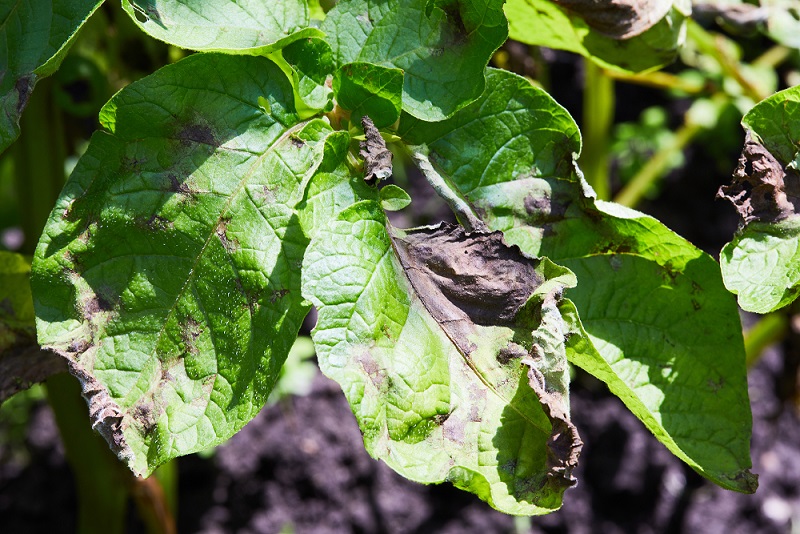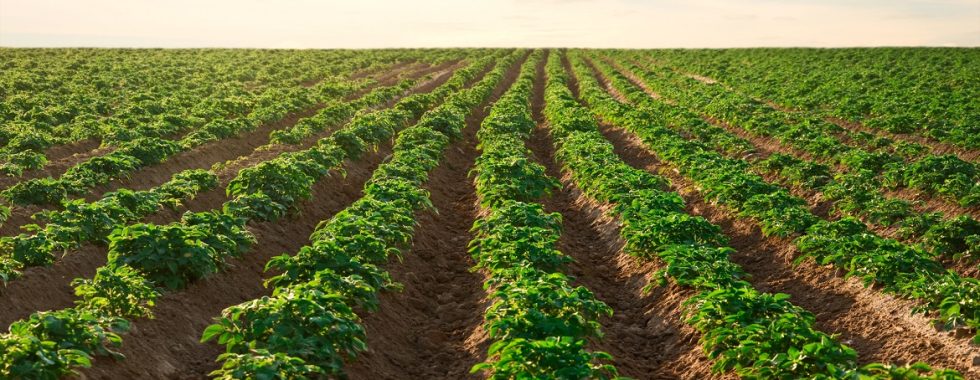Guide to Potato Cultivation: From Planting to Harvest
Success in potato production hinges on informed practices in soil management, nutrient application, and integrated pest and disease control. This guide outlines the essential agronomic considerations for optimizing yield and quality in potato crops.
Planting and Harvesting
Potatoes are typically planted in spring once soil temperatures reach 10°C (50°F), a benchmark for promoting uniform sprouting and robust early growth. Seed tubers should be planted 10–15 cm deep, with in-row spacing of 20–30 cm and row spacing of 75–90 cm. These specifications ensure adequate room for tuber expansion and simplify field operations.
Harvest timing depends on variety and climatic conditions, with maturity generally reached in 90–120 days. Early-maturing varieties, suited for shorter seasons, may be ready in as few as 70–90 days. For optimal storability, harvest when vines have fully died back, indicating the tubers have developed firm skins.
Soil Requirements and Preparation
Soil preparation should include deep tillage to alleviate compaction, which is critical for tuber formation. Drainage is essential—waterlogged conditions increase disease risk, underscoring the need for proper field preparation in wetter climates.
Potatoes are best suited to well-drained, sandy loam soils, with a target pH of 5.5–6.5. High-salinity soils can negatively affect tuber quality and yield, making salt-sensitive varieties particularly vulnerable. Soil type and texture have a significant impact on potato harvest quality and yield. Potatoes perform best in well-drained, sandy loam soils with a loose, friable structure that allows tubers to expand freely without physical restrictions.
The effects of soil type on harvest include:
1. Drainage and aeration: Sandy loam soils provide excellent drainage and aeration, essential for healthy root and tuber development. Poorly drained, heavy clay soils retain excess water, which can lead to waterlogging, oxygen deficiency, and increased risk of diseases like tuber rot. In contrast, overly sandy soils with poor water-holding capacity can lead to water stress, particularly during the critical tuber bulking phase.
2. Soil compaction: Compacted soils restrict tuber expansion, often resulting in smaller or deformed tubers. Looser, well-structured soils minimize compaction and enable tubers to grow uniformly. Compacted layers, often found in heavy soils, impede root and tuber growth, which can reduce overall yield and quality.
3. Tuber quality and shape: Soil texture affects tuber skin quality and shape. Sandy loams tend to produce smooth, well-shaped tubers, while clay-heavy soils increase the likelihood of misshapen tubers due to mechanical resistance. Irregularly shaped tubers can reduce marketability, especially for varieties where visual appearance is critical.
4. Temperature and maturity: Sandy loam soils tend to warm up quickly in spring, allowing for earlier planting and faster crop establishment. This can lead to an earlier harvest, which is advantageous in regions with shorter growing seasons. In cooler, heavy soils, delayed planting may shorten the growing season, impacting yield.
5. Ease of harvest: Sandy loam soils make harvest operations easier and reduce the risk of mechanical damage to tubers during lifting. Heavy clay soils, on the other hand, can cling to tubers, making it harder to separate soil from the crop during harvest. This can increase labor costs and lead to tuber bruising and skinning, which reduces storage quality.
Soil Testing
A thorough soil test several months before planting allows for preemptive pH adjustments and targeted fertilization. Focus the test on pH, organic matter, and critical nutrients—nitrogen (N), phosphorus (P), potassium (K), calcium (Ca), and magnesium (Mg). With these results, growers can establish a tailored nutrient program that meets potato-specific demands, setting a foundation for higher yield potential.
Nutrient Requirements and Fertilization
Potatoes have specific nutrient requirements, and their demand varies throughout growth stages. Nitrogen application should total 150–200 kg/ha (130-180 lbs/acre), split between planting and tuber initiation to sustain vegetative growth without promoting excessive foliage. Phosphorus (P2O5) is generally applied at 60–80 kg/ha pre-planting to support early root development, while potassium (K2O), vital for tuber quality and disease resistance, should be applied at 150–250 kg/ha.
Nutrient imbalances can manifest in potatoes through various symptoms, each impacting tuber quality, plant health, and overall yield. Here are some of the most common nutrient imbalances and their associated symptoms:
Nutrient roles and deficiency symptoms:
Nitrogen deficiency: Nitrogen is essential for foliage growth and photosynthesis. A deficiency typically causes yellowing of older leaves (chlorosis), stunted growth, and reduced tuber size. Plants may exhibit weak stems and poor overall vigor. Excess nitrogen, on the other hand, can lead to excessive foliage growth at the expense of tuber formation, resulting in smaller tubers with lower starch content and poor storage quality.
Phosphorus deficiency: Phosphorus is critical for energy transfer, root development, and early plant establishment. In potatoes, phosphorus deficiency can cause dark green or purplish foliage, particularly on older leaves. Stunted root growth and reduced tuber set are also common symptoms. Low phosphorus levels can delay maturity, leading to lower yields and smaller tubers with reduced starch content.
Potassium deficiency: Potassium plays a key role in water regulation, disease resistance, and tuber quality. Deficiency symptoms include browning and curling of leaf edges, commonly known as leaf scorch, as well as weak, brittle stems. Potassium deficiency also affects tuber quality, often resulting in poor skin texture, lower starch content, and increased susceptibility to bruising and storage rot.
Calcium deficiency: Calcium is vital for cell wall stability and tuber skin quality. Deficiency can cause issues like internal rust spot (small brown flecks within the tuber) and weak tuber skins that are prone to cracking and disease. In severe cases, calcium deficiency may also lead to increased incidence of disorders like hollow heart, particularly in varieties susceptible to this condition.
Tissue Analysis and Timing
Leaf tissue analysis 30–40 days after planting allows for in-season adjustments to nutrient applications. Optimal tissue levels are 4.5–5.5% for nitrogen, 0.3–0.5% for phosphorus, and 6–8% for potassium. These benchmarks guide corrective measures to address any deficiencies that may otherwise limit crop quality or yield.
Sap analysis in potatoes provides real-time data on mobile nutrients like nitrogen and potassium, with optimum sap levels during tuber bulking typically ranging from 1,500–2,500 ppm nitrogen and 4,000–6,000 ppm potassium. While useful for precise adjustments in high-input systems, it is generally supplementary to traditional tissue analysis.
Irrigation Strategy
Water management is crucial in potato production, particularly during the tuber bulking phase. Potatoes have a high demand for water, with crop coefficient (Kc) values varying across growth stages:
- Initial stage (0–30 days): Kc values of 0.4–0.5.
- Tuber development (30–60 days): Kc values increase to 0.8–1.0.
- Midseason bulking (60–90 days): Kc peaks at 1.0–1.2.
- Late season (90–120 days): Kc decreases to 0.6–0.8 as the crop matures.
Regular irrigation, typically every 5–10 days, ensures that water stress does not limit yield. Consistent moisture, especially during tuber bulking, is critical; irregular water supply can result in tuber deformities and reduced market quality.
Pest and Disease Management
Potatoes are susceptible to multiple pests and diseases, necessitating vigilant monitoring and integrated control measures. The Colorado potato beetle (Leptinotarsa decemlineata) poses a significant threat, and insecticide rotation is essential for resistance management.
The potato tuber moth (Phthorimaea operculella) also requires attention, as larvae can damage both foliage and tubers, leading to significant losses in the field and storage.
Aphids warrant control due to their role in virus transmission, which can compromise crop health and quality.
Among diseases, late blight (Phytophthora infestans) and early blight (Alternaria solani) are particularly damaging in humid climates. Regular fungicide applications, based on disease forecasting models, are often necessary to manage these pathogens effectively.
For soil-borne diseases like common scab (Streptomyces spp.), managing soil pH below 5.5 can significantly mitigate infection risks.
Black scurf (Rhizoctonia solani) is another soil-borne pathogen that can affect tuber quality and plant vigor; certified seed, crop rotation, and proper soil conditions can help minimize its impact.
Implementing proper crop rotation and field sanitation practices also reduces the incidence of Verticillium wilt (Verticillium dahliae), a disease that causes yellowing and wilting, especially in fields with a history of infection.
P Late blight in potato
Late blight in potato
Weed Management
Weeds compete for essential resources, and effective control is critical. Pre-plant tillage and residual herbicides establish a clean field at planting, while mechanical cultivation can manage in-season weed pressure until plants reach a height of around 30 cm. Early weed control supports yield potential, as weed interference during early growth stages can severely impact production.
Problems and Symptoms Related to Environmental Stress
Potatoes are highly sensitive to environmental stress, which can lead to various physiological disorders and impact tuber quality and yield. Common issues associated with environmental stress include heat stress, irregular watering, and nutrient imbalances, each producing distinct symptoms that require careful management to mitigate their effects.
Heat stress: High temperatures, especially above 30°C (86°F), can significantly reduce tuber formation and lead to smaller tubers. Heat stress also affects the overall health of the plant, causing wilting, reduced photosynthesis, and increased susceptibility to diseases. In extreme cases, heat can result in malformed or cracked tubers. Ensuring adequate soil moisture and mulching can help lower soil temperatures, protecting developing tubers.
Water stress and inconsistent irrigation: Both drought and excessive moisture can lead to problems in potato crops. Drought stress results in smaller tubers and uneven sizes, as tuber bulking is hampered by water shortages. Inconsistent irrigation can cause disorders like hollow heart (internal cavities within tubers) and brown center (necrotic tissue in the center of the tuber), which are often observed when rapid tuber growth follows a period of water stress. To avoid these issues, maintain consistent soil moisture, particularly during the tuber bulking stage.
Cold Stress: Cold temperatures, especially when they occur suddenly, can also affect potato growth. Frost or sudden temperature drops can damage foliage, reducing photosynthetic capacity and slowing down tuber growth. Tubers subjected to cold stress early in the growing season may develop misshapen forms or suffer from delayed maturity, leading to lower marketable yields. Avoid planting in soil that hasn’t sufficiently warmed in spring, and consider frost protection measures where applicable.
Harvest and Storage
Harvesting should only proceed once the vines have died back, as this ensures tubers have matured fully. Proper handling during harvest minimizes bruising, reducing post-harvest losses. Potatoes should be stored at 7–10°C (45–50°F) with high humidity (90–95%) to prolong storage life, preventing dehydration and sprouting.






